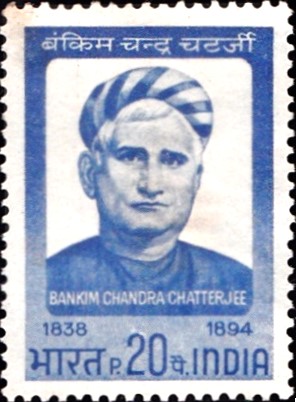
Bankim Chandra Chatterjee
A commemorative postage stamp on the 130th birth anniversary of Bankimchandra Chattopadhyay, an Indian Bengali writer, poet and journalist from Bengal Renaissance, composer of Vande Mataram :
 Issued by India
Issued by India
Issued on Jan 1, 1969
Issued for : The Indian P & T Department is happy to salute the memory of this great writer and patriot by issuing a special stamp in his honour on New Year’s Day, 1969.
Description of Design : The design is vertical and depicts a portrait of Bankim Chandra Chatterjee.
Type : Stamp, Mint Condition
Colour : Blue
Denomination : 20 Paise
Overall Size : 3.34 X 2.46 cms.
Printing Size : 2.99 X 2.10 cms.
Perforation : 13½ x 14
Watermark : Printed on unwatermarked paper
Number Printed : 30,00,000
Number per issue Sheet : 54
Printing Process : Photogravure
Designed and Printed at : India Security Press
Name : Bankim Chandra Chattopadhyay
Born on Jun 26, 1838 at Kanthalpara, North 24 Parganas, West Bengal, India
Died on Apr 8, 1894 at Kolkata, West Bengal, India
About :
- Bankim Chandra Chattopadhyay was born on 26th June, 1838 in the village of Katalpara near Naihati in West Bengal. He was educated at the Hooghly College and the Presidency College, Calcutta and was among the first products of the newly-founded Calcutta University. Soon after graduation, he was appointed Deputy Collector under the then Government, an office which he held till his retirement.
- He wrote poetry to begin with, but his efforts were no great success. He then turned to fiction and his first novel “Raj Mohan’s Wife” written in English appeared in 1864. He soon outgrew the contemporary craze for writing in English, and his next novel “Durgesh Nandini” was written in Bengali. The appearance of this work in 1865 was a landmark in India’s literary history. It was the first novel written in Bengali in the European style. “Durgesh Nandini” thus heralded the birth of a new literary era not only in Bengal but in the whole of India. Although it was not Bankim Chandra’s best work, it became immensely popular and filled the reader with unprecedented delight. Rabindranath Tagore has compared its publication to the appearance of dawn after night.
- Novels came out thereafter in quick succession from Bankim Chandra’s fertile pen. “Kapal Kundala”, his most imaginative story, appeared in 1866, followed by “Mrinalini”. Many of his later novels were first published serially in the magazine “Bangadarsan” which Bankim founded in 1872. Among these were “Visa Vriksha” (his first social novel), “Krishna Kanter Will“, “Ananda Math” and “Devi Choudhurani”. Besides novels, he wrote several volumes of essays, sketches and dissertations. From 1872 till his death in 1894, Bankim Chandra was the leading figure in the literary circles of Bengal.
- He came closest to the heart of the people and the names of his characters became household words in Bengal. His novels have been translated into other Indian languages and his reputation is, therefore, not confined to Bengal. A feature of his writings, unique for his times, is the spirit of patriotism that breathes through many of them. He is not only the father of modern Indian fiction, but has also earned an honoured place in the history of India’s struggle for freedom. A measure of his influence on the freedom movement is the popularity of the nationalist song “Bande Mataram” which occurs in his novel “Ananda Math”. Even today, the popularity of this song is second only to that of the National Anthem.


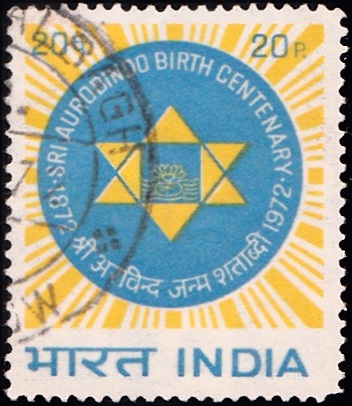
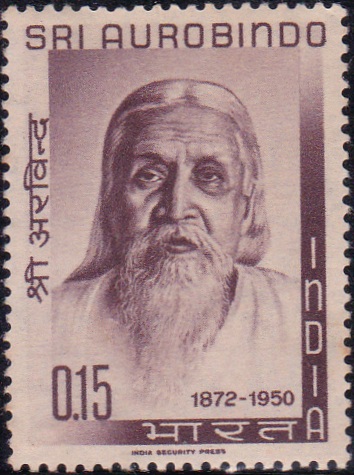
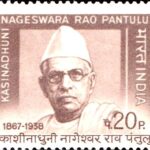
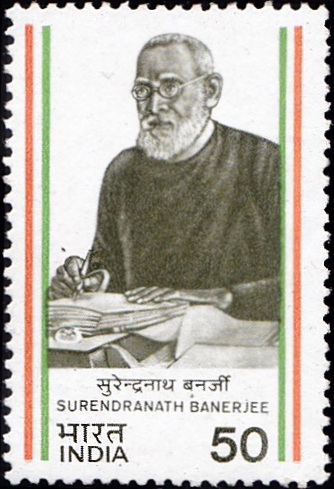
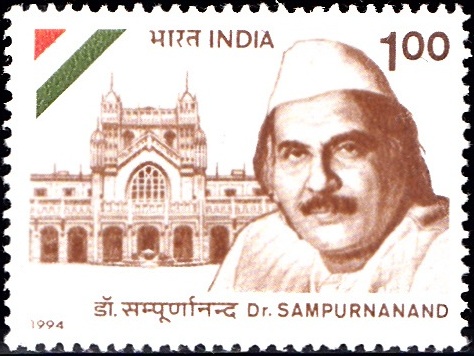

[…] by Satyendranath Tagore was adopted in 1867. It was also in this very city that it was replaced by Bankim Chandra’s “Bande Mataram” in 1875, which soon become the slogan for national unity and freedom […]
[…] father of the armed struggle for India‘s freedom and it is said that it was he who inspired Bankim Chadra Chatterjee to write the patriotic novel “Anand Math“. This pioneer revolutionary who died at […]
[…] Mataram‘, the immortal song composed by Bankim Chandra Chatterjee, is more than a hundred years old. Though it first appeared in the first instalment of […]
[…] articles on contemporary topics. He translated many Bengali works in Hindi including the works of Bankim Chandra Chattopadhyaya and Ishwar Chandra Vidyasagar. Besides being a writer, Pratap Narayan Mishra also laid down the […]
[…] to Santiniketan with his family, Tagore revived Bankim Chandra Chattopadhyaya‘s monthly journal ‘Bangadarshan‘. The nucleus of Santiniketan was begun in 1901 […]
[…] works are classed with the greats in Indian literature like Bankim Chandra Chatterjee and Harinarayan Apte. The novels “Marthanda Varma“, “Dharmaraja” […]
[…] In the course of his career, he treated several notable persons of those days, including the author Bankim Chandra Chattopadhyay, the saintly Ramakrishna Paramahansa, the Maharaja of Tripura and […]